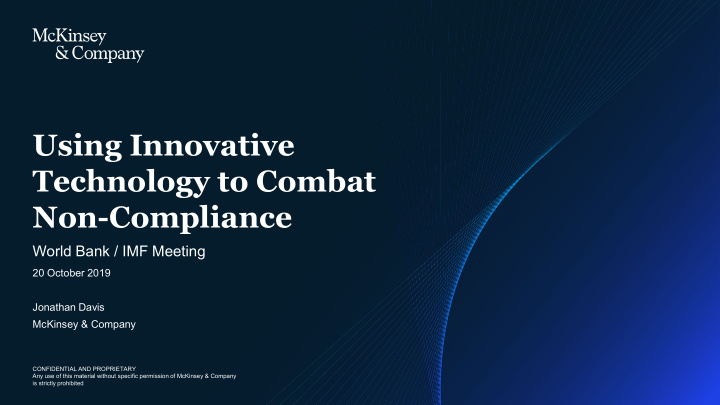



Using Innovative Technology to Combat Non-Compliance World Bank / IMF Meeting 20 October 2019 Jonathan Davis McKinsey & Company CONFIDENTIAL AND PROPRIETARY Any use of this material without specific permission of McKinsey & Company is strictly prohibited
Revenue authorities have complex mission, and are charged with addressing myriad forms of non-compliance Tax non-compliance “Shadow” economy Non-payment of assessed within the formal sector activity that goes untaxed tax debt Customs duty evasion Improper use of tax / duty Fraudulent refund claims concessions McKinsey & Company McKinsey & Company 2 2
There are a number of exciting applications of technology and analytics that have shown real world results Illustrative examples Use of government and private sector data to independently estimate how much income should be reported versus what is reported, or where a tax return should have been filed when it wasn’t Using analytics to identify likelihood of default / write- off to prioritise efforts to collect past due tax debts Conducting more sophisticated network analysis to reveal previously hidden networks, and patterns of business (re)creation McKinsey & Company McKinsey & Company 3 3
Each revenue authority has its own unique starting point: effective use of data and analytics involves a journey Revenue authorities Example: Those with Example: with very limited foundational Transforming Connecting the dots data and IT building blocks of performance of the across government data infrastructure can IT infrastructure can workforce (e.g., by sources to identify launch high-impact pursue, in stages, building integrated view undeclared business revenue more sophisticated of auditor/collector activities (e.g., using tax, enhancement data analysis performance by office, customs, companies programmes capabilities improving segmentation house data – as grounded in data of debt stock, improving permitted) allocation of audit cases to skill levels, calibrating time spent per case with revenue risk, etc.) McKinsey & Company 4
These themes are evergreen – why now? 1 2 3 Costs of data storage have Tools to cleanse Data quality challenges plummeted and integrate data can increasingly be have matured mitigated (though not enormously eliminated) 4 5 6 Organisations have learned to Lighthouse Where there have been pursue analytics impact in examples of false starts, valuable parallel with IT modernization success exist in lessons have been several tax learned authorities McKinsey & Company McKinsey & Company 5 5
Some learnings are globally applicable, while others require highly context-specific judgment We find some universally applicable themes… And others that are highly situation-specific Legacy IT systems and poor data integration are Level of support of ministers for change programme with a challenge everywhere simultaneous commitment to allow revenue authority to act with independence Clear, understandable analysis is typically more successfully adopted than highly advanced techniques that are a “black box” Level of cooperation and collaboration among tax and to the people using them customs agencies There is significant value that can be captured just through Extent to which first step is marshalling the data versus better integration of data sources internal to government figuring out how to use it There are colleagues within the revenue administration Public expectations and acceptance of data usage to improve who are yearning to work differently – they just need an levels of tax compliance opportunity to raise their hands Skills and capabilities of the workforce with willingness / Prudent investments in technology and data in revenue excitement to learn and grow administration are high ROI (particularly if structured to be self-funding from early in the process) McKinsey & Company McKinsey & Company 6 6
Successful initiatives share a handful of common traits Choose compliance interventions designed to quickly boost Ensure committed senior-level revenue and compliance sponsorship and commitment The organisation and stakeholders Senior leaders alone can create an will be watching closely, quick wins will environment where change is possible in build excitement the face of long-standing practices Keep disciplined link of analytics Place a premium activities to sources of value on accountability and speed Avoid data and technology for its own Create a culture of performance – with sake, and ensure that analytics and clear daily / weekly / monthly performance operational changes are directly tied to management cadence, and peers holding high impact outcomes each other accountable for results McKinsey & Company 7
While advanced analytics bring deep new capabilities, there are risks that need to be managed Example: AI can generate high impact, however These risks emerge from a increasingly complex models can lack handful of typical root explainability causes… There are real world private sector examples where 1 Unintended biases use of AI outpaced ability to manage risk, such as: Algorithmically-generated offers that systematically 2 Overfitting models favoured neighbourhoods of a particular racial 3 Non-representative composition training data Facial recognition technology that performed poorly Lack of testing 4 on certain ethnicities in extreme situations Sentiment analysis algorithms ranking as “positive” 5 Learning systems that comments that included deeply offensive language are vulnerable to manipulation Speech-to-text algorithms whose performance varied widely by gender Chatbot that posted offensive and inflammatory tweets after mimicking posts from other users McKinsey & Company McKinsey & Company 8 8
To the Panel for Discussion… Contact: Jonathan Davis jonathan_m_davis@mckinsey.com +1 202 662 1175 McKinsey & Company 9
Recommend
More recommend